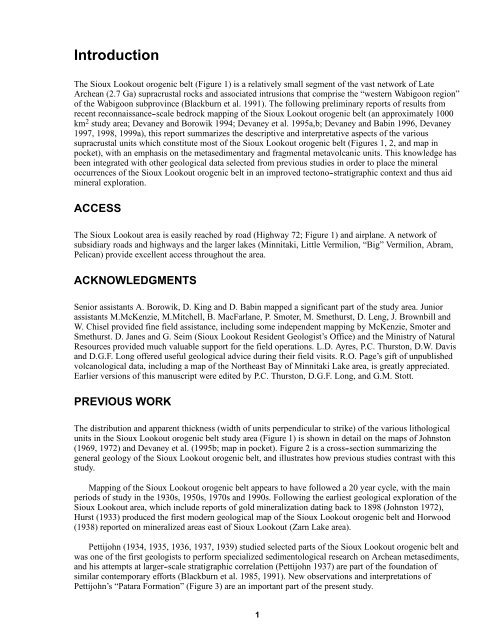Regional Geology, Sioux Lookout Orogenic Belt - Geology Ontario
Regional Geology, Sioux Lookout Orogenic Belt - Geology Ontario
Regional Geology, Sioux Lookout Orogenic Belt - Geology Ontario
Create successful ePaper yourself
Turn your PDF publications into a flip-book with our unique Google optimized e-Paper software.
Introduction<br />
The <strong>Sioux</strong> <strong>Lookout</strong> orogenic belt (Figure 1) is a relatively small segment of the vast network of Late<br />
Archean (2.7 Ga) supracrustal rocks and associated intrusions that comprise the “western Wabigoon region”<br />
of the Wabigoon subprovince (Blackburn et al. 1991). The following preliminary reports of results from<br />
recent reconnaissance--scale bedrock mapping of the <strong>Sioux</strong> <strong>Lookout</strong> orogenic belt (an approximately 1000<br />
km 2 study area; Devaney and Borowik 1994; Devaney et al. 1995a,b; Devaney and Babin 1996, Devaney<br />
1997, 1998, 1999a), this report summarizes the descriptive and interpretative aspects of the various<br />
supracrustal units which constitute most of the <strong>Sioux</strong> <strong>Lookout</strong> orogenic belt (Figures 1, 2, and map in<br />
pocket), with an emphasis on the metasedimentary and fragmental metavolcanic units. This knowledge has<br />
been integrated with other geological data selected from previous studies in order to place the mineral<br />
occurrences of the <strong>Sioux</strong> <strong>Lookout</strong> orogenic belt in an improved tectono--stratigraphic context and thus aid<br />
mineral exploration.<br />
ACCESS<br />
The <strong>Sioux</strong> <strong>Lookout</strong> area is easily reached by road (Highway 72; Figure 1) and airplane. A network of<br />
subsidiary roads and highways and the larger lakes (Minnitaki, Little Vermilion, “Big” Vermilion, Abram,<br />
Pelican) provide excellent access throughout the area.<br />
ACKNOWLEDGMENTS<br />
Senior assistants A. Borowik, D. King and D. Babin mapped a significant part of the study area. Junior<br />
assistants M.McKenzie, M.Mitchell, B. MacFarlane, P. Smoter, M. Smethurst, D. Leng, J. Brownbill and<br />
W. Chisel provided fine field assistance, including some independent mapping by McKenzie, Smoter and<br />
Smethurst. D. Janes and G. Seim (<strong>Sioux</strong> <strong>Lookout</strong> Resident Geologist’s Office) and the Ministry of Natural<br />
Resources provided much valuable support for the field operations. L.D. Ayres, P.C. Thurston, D.W. Davis<br />
and D.G.F. Long offered useful geological advice during their field visits. R.O. Page’s gift of unpublished<br />
volcanological data, including a map of the Northeast Bay of Minnitaki Lake area, is greatly appreciated.<br />
Earlier versions of this manuscript were edited by P.C. Thurston, D.G.F. Long, and G.M. Stott.<br />
PREVIOUS WORK<br />
The distribution and apparent thickness (width of units perpendicular to strike) of the various lithological<br />
units in the <strong>Sioux</strong> <strong>Lookout</strong> orogenic belt study area (Figure 1) is shown in detail on the maps of Johnston<br />
(1969, 1972) and Devaney et al. (1995b; map in pocket). Figure 2 is a cross--section summarizing the<br />
general geology of the <strong>Sioux</strong> <strong>Lookout</strong> orogenic belt, and illustrates how previous studies contrast with this<br />
study.<br />
Mapping of the <strong>Sioux</strong> <strong>Lookout</strong> orogenic belt appears to have followed a 20 year cycle, with the main<br />
periods of study in the 1930s, 1950s, 1970s and 1990s. Following the earliest geological exploration of the<br />
<strong>Sioux</strong> <strong>Lookout</strong> area, which include reports of gold mineralization dating back to 1898 (Johnston 1972),<br />
Hurst (1933) produced the first modern geological map of the <strong>Sioux</strong> <strong>Lookout</strong> orogenic belt and Horwood<br />
(1938) reported on mineralized areas east of <strong>Sioux</strong> <strong>Lookout</strong> (Zarn Lake area).<br />
Pettijohn (1934, 1935, 1936, 1937, 1939) studied selected parts of the <strong>Sioux</strong> <strong>Lookout</strong> orogenic belt and<br />
was one of the first geologists to perform specialized sedimentological research on Archean metasediments,<br />
and his attempts at larger--scale stratigraphic correlation (Pettijohn 1937) are part of the foundation of<br />
similar contemporary efforts (Blackburn et al. 1985, 1991). New observations and interpretations of<br />
Pettijohn’s “Patara Formation” (Figure 3) are an important part of the present study.<br />
1

















